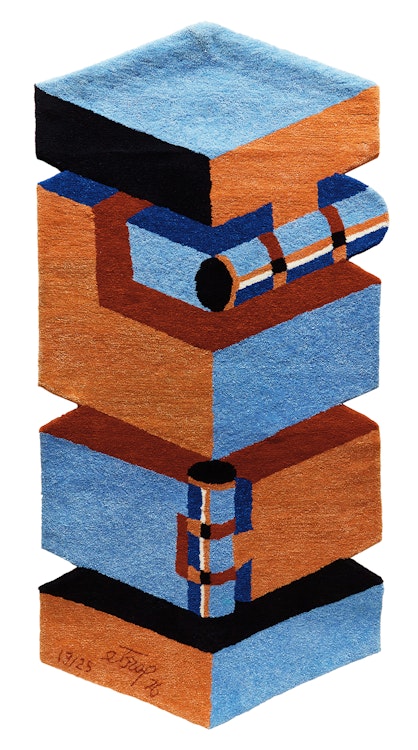Untitled Tapestry by Sorel Etrog

Sorel Etrog
Untitled Tapestry
acrylic fibre tapestery
woven signature, date (1976) and edition (13/25) lower left; unframed
97.5 x 49.5 ins ( 247.7 x 125.7 cms ) ( overall )
Auction Estimate: $3,000.00 - $5,000.00
Price Realized $3,840.00
Sale date: December 3rd 2020
Private Collection, Ontario
“Canadian Tapestries 1977: an exhibition of 23 tapestries designed by Canadian painters and sculptors”, Art Gallery of Toronto, 1977, pages 5, and 20-21
Sorel Etrog designed a tapestry of coloured and shaded blocks for inclusion in this exhibition, drawing upon his “Hinge” works of the late 1970s. Etrog recalls: “On a vacation in Israel, visiting my family, I picked up a child’s drawing pad and began to draw doodles of flat and organic surfaces connected by hinges… The hinge started to obsess me and so I adopted it.” Etrog’s design for “Untitled Tapestry”, a variation on the textile work included in the 1977 exhibition, is naturally reflective of the artist’s work in other media, and is a marked contrast between medium and articulated forms.
Share this item with your friends
Sorel Etrog
(1933 - 2014) RCA
Based in Toronto for more than fifty years, Sorel Etrog was born in Iasi, Romania, in 1933. He is most well-known as a sculptor, but he also illustrated books, painted, and wrote poetry, plays, and films. His sculptures were influenced by his adolescence spent under Soviet rule and an interest in philosophical writings that questioned the nature of post-war society. He was also inspired by his grandfather who was a carpenter. Etrog, along with his parents and sister attempted to flee Romania in 1946 but were caught. His parents were then imprisoned for several weeks. Finally, Etrog and his family left Romania in 1950 and made it to the Sha’ar Aliyaa refugee camp near Haifa, Israel.
While serving mandatory time in the Israel Defense Forces’ medical corps in 1953 he began studying art at Tel Aviv’s Arts Institute for Painting and Sculpture. Inspired by Cubist collage and modernist music, he created three-dimensional paintings, mimicking constructivist reliefs. In 1958, he received a scholarship to attend school at the Brooklyn Museum of Art School.
Upon arrival in New York City, Etrog became drawn to African and Oceanic art due to their expressive shapes and began incorporating these elements into his work. While trying to find gallery representation in New York City, Samuel J. Zachs purchased one of Etrog’s paintings and invited Etrog to spend the summer of 1959 in Southampton on Lake Huron with him. While in Southampton, Etrog created his first wooden sculptures and gained gallery representation from Gallery Moos in Toronto. This encounter inspired the young artist to apply for Canadian citizenship and eventually move to Toronto in 1963.
In his mature sculptural works, Etrog explores spontaneous symbols, primal elements and the relationship between form and symbol. The artist described his art as "tension created by pulling together and pulling apart, with being stuck and being freed, a world of grabbing and holding on and losing hold...bringing shapes together but at the same time giving each an independence."
After immigrating to Canada, Etrog had his first traveling exhibition in 1965. The show began at Gallery Moos, then traveled to New York City, Los Angeles, and Montreal. In 1966, Etrog, alongside Yves Gaucher and Alex Colville, represented Canada at the Venice Biennale. He later received several important commissions, including those for Expo ’67, Montreal; SunLife Centre, Toronto; Windsor Sculpture Garden, Windsor, Ontario; Los Angeles County Museum, and Olympic Park in Seoul, Korea. Before his death in 2014, Etrog’s art was included in a retrospective at Buschlen Mowatt in Vancouver in 2003.
Literature Sources:
"A Dictionary of Canadian Artists, Volume I: A-F", compiled by Colin S. MacDonald, Canadian Paperbacks Publishing Ltd, Ottawa, 1977
Mikulinsky, Alma, “Sorel Etrog: Life and Work,” Toronto: Art Canada Institute, 2018
We extend our thanks to Danie Klein, York University graduate student in art history, for writing and contributing this artist biography.

